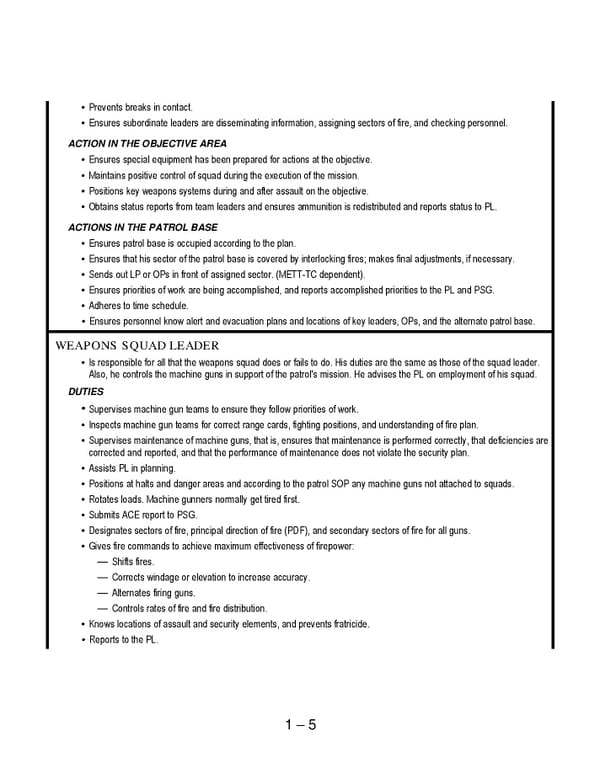1 – 5 • Prevents breaks in contact. • Ensures subordinate leaders are disseminating information, assigning sectors of fire, and checking personnel. ACTION IN THE OBJECTIVE AREA • Ensures special equipment has been prepared for actions at the objective. • Maintains positive control of squad during the execution of the mission. • Positions key weapons systems during and after assault on the objective. • Obtains status reports from team leaders and ensures ammunition is redistributed and reports status to PL. ACTIONS IN THE PATROL BASE • Ensures patrol base is occupied according to the plan. • Ensures that his sector of the patrol base is covered by interlocking fires; makes final adjustments, if necessary. • Sends out LP or OPs in front of assigned sector. (METT-TC dependent). • Ensures priorities of work are being accomplished, and reports accomplished priorities to the PL and PSG. • Adheres to time schedule. • Ensures personnel know alert and evacuation plans and locations of key leaders, OPs, and the alternate patrol base. WEAPONS SQUAD LEADER • Is responsible for all that the weapons squad does or fails to do. His duties are the same as those of the squad leader. Also, he controls the machine guns in support of the patrol's mission. He advises the PL on employment of his squad. DUTIES • Supervises machine gun teams to ensure they follow priorities of work. • Inspects machine gun teams for correct range cards, fighting positions, and understanding of fire plan. • Supervises maintenance of machine guns, that is, ensures that maintenance is performed correctly, that deficiencies are corrected and reported, and that the performance of maintenance does not violate the security plan. • Assists PL in planning. • Positions at halts and danger areas and according to the patrol SOP any machine guns not attached to squads. • Rotates loads. Machine gunners normally get tired first. • Submits ACE report to PSG. • Designates sectors of fire, principal direction of fire (PDF), and secondary sectors of fire for all guns. • Gives fire commands to achieve maximum effectiveness of firepower: — Shifts fires. — Corrects windage or elevation to increase accuracy. — Alternates firing guns. — Controls rates of fire and fire distribution. • Knows locations of assault and security elements, and prevents fratricide. • Reports to the PL.
 Ranger Handbook Page 16 Page 18
Ranger Handbook Page 16 Page 18